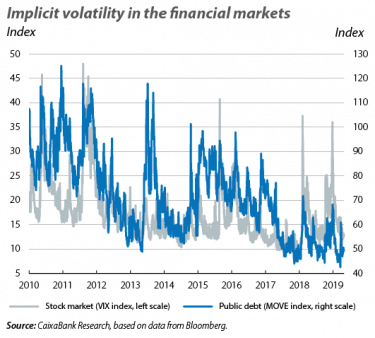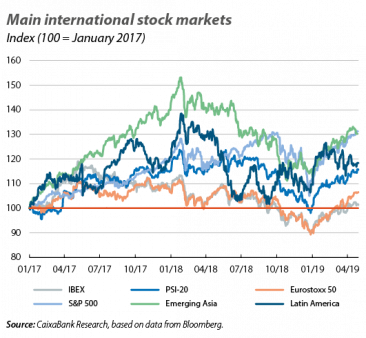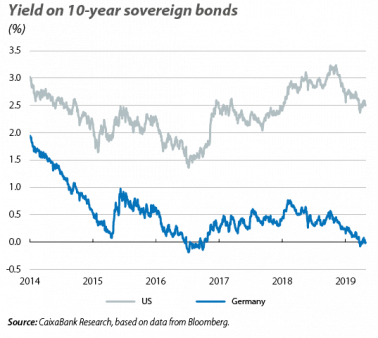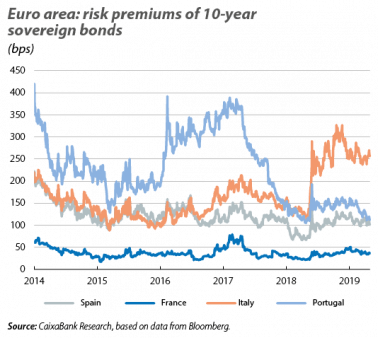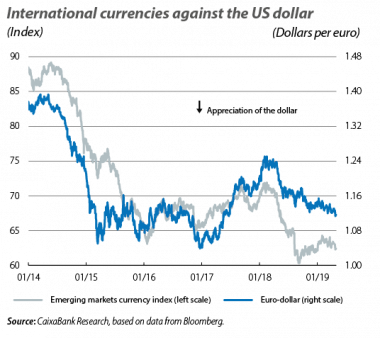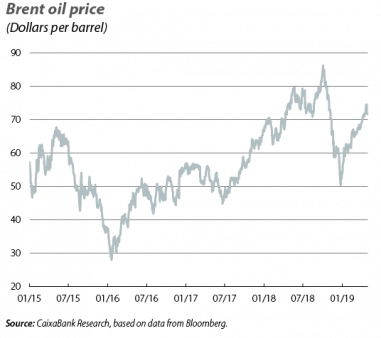Investor optimism returns. In April, the publication of economic activity data and encouraging business profits contributed to the recovery of investor sentiment, which had been somewhat wary in March. In addition to the progress in the trade negotiations between the US and China and central banks continuing to express their intention not to tighten their monetary policy in the coming quarters, in April this supported a reduction in volatility in the financial markets, a recovery in yield rates (which had fallen in March) and greater buoyancy in the stock markets. However, as was emphasised by the ECB (at its April meeting) and the various communications of other major central banks, the main risks surrounding the growth scenario remained tilted to the downside and, as already happened in previous quarters, could lead to new spikes of volatility.
The stock markets show stronger growth. The recovery of investor sentiment was especially noted in the equity markets. They also benefited from a good start to the season of the publication of business profits relating to Q1 2019, given that, in the US in particular, most of the results reported up until the closing date of this Monthly Report exceeded market expectations (it should be recalled that, at the end of 2018, analysts lowered their general expectations due to the prospect of a slowdown in global economic activity). Thus, after brining a strong first quarter to a close (+13% in the case of the MSCI World Index), albeit with a less optimistic final month of March, in April the main international stock markets showed renewed buoyancy. In particular, the US’ S&P 500 rose by around 4% and exceeded its all-time high registered in September 2018. In Europe, meanwhile, the Eurostoxx 50 rose by around 5%, as a result of good performance both in the economies of the core of the euro area and in those of the periphery.
Sovereign debt yields recover. While in March sovereign interest rates had dropped due to investors’ doubts over global growth, in April they recovered thanks to the improvement in sentiment and, in particular, the publication of good economic growth data in China, the US and the euro area (see the International Economy section in this same Monthly Report). In particular, sovereign interest rates in Germany and the US rose steadily and Germany’s 10-year yield returned to positive territory. In addition, the inversion of the US sovereign yield curve was reversed (after lasting just one week, a much shorter period than on previous occasions when the inversion of the yield curve had predicted a recession around a year in advance). In the periphery of the euro area, meanwhile, the risk premiums of Spain and Portugal fell by around 20 bps, while Italy’s differential remained stable due to the persistence of doubts over the country’s fiscal policy.
An ECB on hold puts the spotlight on the downside risks. As expected, at its meeting in April, the ECB left the parameters of its monetary policy unchanged and focused on analysing the state of the euro area’s economy. The institution reiterated a relatively positive outlook for the medium term, emphasising that the likelihood of recession for the region is low and that the moderation of growth is a response to temporary factors and headwinds of a global nature (such as geopolitical tensions and the slowdown in China), while the dynamism of the labour market and domestic demand support the continuity of the expansion. In the short term, however, the ECB indicated that the economic activity data remained weak, particularly in the manufacturing sector (the meeting was prior to the publication of the euro area’s GDP for Q1, which was higher than expected), and it recalled that the outlook remains dominated by major downside risks. As such, the entity undertook to closely monitor the evolution of the economy and the extent to which the current bump that the euro area is experiencing persists. This assessment will be key when it comes to making new decisions in upcoming meetings, such as on the cost at which the targeted longer-term refinancing operations (TLTROs) announced in March will be offered, or the assessment as to whether the ECB should take measures to mitigate the possible adverse effects of a prolonged period of low interest rates.
The Fed maintains its discourse of patience. Although the US economy is growing at a solid rate and the labour market is in full employment, the absence of firmer inflationary pressures and the prospect of the economy slowing down in the coming quarters have led the Fed to pause its cycle of interest rate hikes which it began in 2015. It even went as far as noting that it does not anticipate any rise in the reference rates in 2019. Following on from this, the most recent messages from the members of the Fed suggest that sustained increases in inflation above 2% would be needed prior to tightening monetary policy again. They also suggest that the institution will remain patient over the coming months, waiting to see how the economic indicators evolve before taking any decisions on interest rate changes.
Oil prices rise. In the context of improved investor sentiment in April, the price of a barrel of Brent oil continued to rise, temporarily exceeding 75 dollars after the US confirmed the end of the exemptions to sanctions on importers of Iranian crude oil. This was added to statements from some OPEC members that they would not take any major measures to compensate for lower exports from Iran, although OPEC and its main partners must still assess the extension of the agreement on production cuts that has supported the recovery in the price of crude oil in recent months (probably at its meeting in June).
